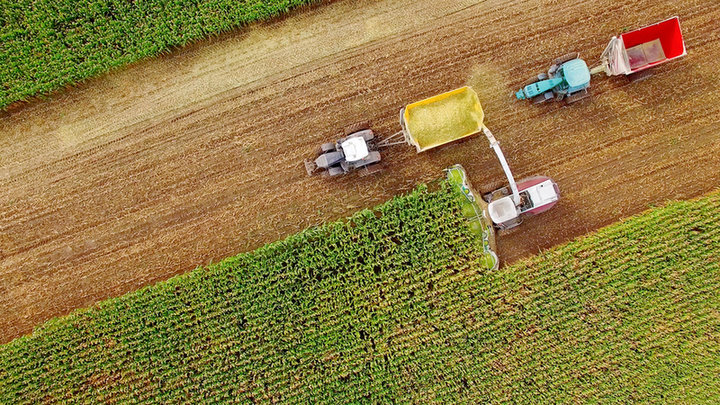Smartagrihubs
introduction

Kerstin Rosenow
Head of Unit Research and Innovation
DG AGRI, European Commission
Dear readers,
Arable crops, on which this newsletter focusses, form an important part of agricultural production by accounting for 45% of total utilised agricultural area in the EU in 2018.1
Currently the sector is facing several challenges – such as increasing societal demands for environmental performance and food quality as well as the short- and long-term effects of climate change. Therefore, like many sectors, arable crops are confronted with uncertainties because of changing political and economic conditions.
On the other hand, the possibilities to adapt arable crop production patterns to cope with such challenges are generally quite good, if compared to the production of e.g. permanent crops, where crops and/ or varieties are not changed that frequently. Changes in production patterns can be observed for instance, with a dynamic growth of organic farming and a tendency to use more heat- and or/ drought resistant varieties in certain regions.
Arable crops are confronted with uncertainties because of changing political and economic conditions.
The adaptation of production to changing basic conditions and to cope with uncertainties and higher demands on production standards, can be approached in various ways. The increased use of digital technologies to strengthen agricultural production capacities, its resilience and efficiency as well as related management capabilities can be game changers in this context. Digital technologies bring substantial benefit to the various production lines and approaches in arable cropping along the whole supply chain – be it organic or conventional; large-scale or small-scale farming.2
Digital technologies to support arable production have been developed and are applied regionally to different extents and vary by type of technology. However, going from the development of innovative approaches and technology by researchers to their application at larger scale in agricultural production, is a long way. Limiting factors in this context include a lack of awareness or skills or capital on farms. Against this background – looking at the comprehensive approach followed in SmartAgriHubs – I believe it is important to highlight that the project does not only foster digital innovation, but also addresses social innovation. In many rural regions and for many agricultural stakeholders, the hub concept – as a “one-stop shop” for e.g. sharing innovative ideas, receiving advice, and in some cases also for learning about financing models for new technologies - is a novelty. The hubs offer the opportunity to bring research results to farmers and food processors in a tailored way.3

Finally, I would also like to highlight another key feature of SmartAgriHubs: EU-wide networking. EU-wide exchange of experiences, technologies and approaches is becoming increasingly important in many policy fields. I can observe the positive effects of the EU-wide sharing of good practices between European Innovation Partnership (EIP)-AGRI Operational Groups.4 The EIP-AGRI – build synergies between the Common Agricultural Policy and the EU Research & Innovation policy (Horizon2020) and connect scientists and farmers as well as other practitioners. With its innovative Operational Groups, multi-actor projects and thematic networks it has evolved to a powerful tool to foster innovation in the agricultural sector through the co-creation of knowledge, the development of solutions for practical problems and their dissemination to a wider EU audience. EIP-AGRI results are likely to be of interest to the SmartAgriHubs community as well and provide another opportunity for cross-fertilisation between project communities.
For SmartAgriHubs, the European outreach and exchange are particularly relevant, and I encourage project partners to make effective use of the network structures. For instance, for the adaptation of production patterns of arable crops to climate change, there is a need to opt for new varieties previously grown in other regions. EU-wide networking is an asset for tailored adaptation of crop production systems. Sharing (digital) reference data and experience from regions, which have a track-record of production data under similar conditions for example, can help circumvent the need for data time series for targeted and strategic production management.5
I wish the project partners and followers an inspiring exchange of experience about the application and use of digital technologies, fruitful cooperation, and effective cross-sectoral networking. I would be happy to hear about more results and lessons learnt from the SmartAgriHubs community.
Signed,
Kerstin Rosenow,
Head of Unit Research and Innovation,
DG AGRI, European Commission
Read Footnotes
Footnotes
European Commission EU Agricultural Outlook report 2018: https://ec.europa.eu/info/sites/info/files/food-farming-fisheries/farming/documents/medium-term-outlook-2018-report_en.pdf.
Certainly, some digital solutions and applications tend to be more (cost-) effective on larger parcels due to the limited resolution of freely available earth observation data. This is an advantage for arable production, where parcel sizes tend to be larger, even if there are strong regional differences.
For farmers and food processors as “end users”, innovation hubs create an enabling environment for the use of a certain digital technology. It is not the end user, who has to identify key supporting actors, but relevant social networks within a region are pre-established, including e.g. farm advisors familiar with that technologies or public organisations helping with related application processes.
For more information about the EIP-AGRI, see https://ec.europa.eu/eip/agriculture/en/about.
Taking an example from the SmartAgriHubs portfolio in the domain of the arable sector, such data exchange might be relevant for instance in the context of the Flagship Innovation Experiment No 15, which focusses on decision making support for small-scale precision farming based on e.g. sensor and climatic data to feed the underlying software.
